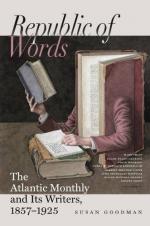there is less agreement than ever among naturalists
as to what the basis is in Nature upon which our idea
of species reposes, or how the word is practically
to be defined. Indeed, when we consider the endless
disputes of naturalists and ethnologists over the human
races, as to whether they belong to one species or
to more, and if to more, whether to three, or five,
or fifty, we can hardly help fancying that both may
be right,—or rather, that the uni-humanitarians
would have been right several thousand years ago,
and the multi-humanitarians will be a few thousand
years later; while at present the safe thing to say
is, that, probably, there is some truth on both sides.
“Natural selection,” Darwin remarks, “leads
to divergence of character; for more living brings
can be supported on the same area the more they diverge
in structure, habits, and constitution,” (a
principle which, by the way, is paralleled and illustrated
by the diversification of human labor,) and also leads
to much extinction of intermediate or unimproved forms.
Now, though this divergence may “steadily tend
to increase,” yet this is evidently a slow process
in Nature, and liable to much counteraction wherever
man does not interpose, and so not likely to work
much harm for the future. And if natural selection,
with artificial to help it, will produce better animals
and better men than the present, and fit them better
to “the conditions of existence,” why,
let it work, say we, to the top of its bent.
There is still room enough for improvement. Only
let us hope that it always works for good: if
not, the divergent lines on Darwin’s diagram
of transmutation made easy ominously show what small
deviations from the straight path may come to in the
end.
The prospect of the future, accordingly, is on the
whole pleasant and encouraging. It is only the
backward glance, the gaze up the long vista of the
past, that reveals anything alarming. Here the
lines converge as they recede into the geological
ages, and point to conclusions which, upon the theory,
are inevitable, but by no means welcome. The
very first step backwards makes the Negro and the
Hottentot our blood-relations;—not that
reason or Scripture objects to that, though pride
may. The next suggests a closer association of
our ancestors of the olden time with “our poor
relations” of the quadrumanous family than we
like to acknowledge. Fortunately, however,—even
if we must account for him scientifically,—man
with his two feet stands upon a foundation of his
own. Intermediate links between the Bimana
and the Quadrumana are lacking altogether; so
that, put the genealogy of the brutes upon what footing
you will, the four-handed races will not serve for
our forerunners;—at least, not until some
monkey, live or fossil, is producible with great toes,
instead of thumbs, upon his nether extremities; or
until some lucky geologist turns up the bones of his
ancestor and prototype in France or England, who was




